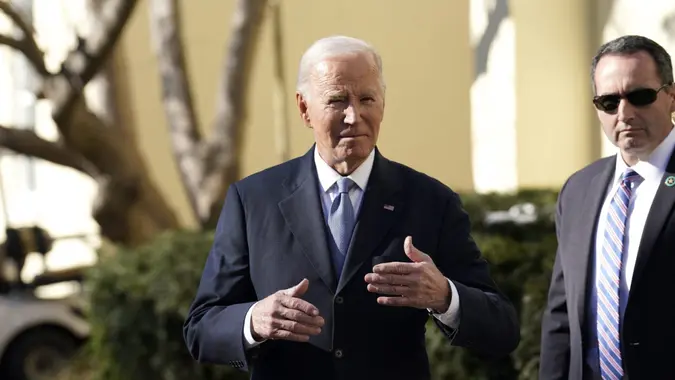How Biden’s Term Affected Inflation — And What It Means for Your Money in 2025

Commitment to Our Readers
GOBankingRates' editorial team is committed to bringing you unbiased reviews and information. We use data-driven methodologies to evaluate financial products and services - our reviews and ratings are not influenced by advertisers. You can read more about our editorial guidelines and our products and services review methodology.

20 Years
Helping You Live Richer

Reviewed
by Experts

Trusted by
Millions of Readers
Since President Donald Trump has been back in the White House for over a month, naturally much of the economic focus is on his administration’s policies. However, every president inherits the economic situation of their predecessor.
How did President Joe Biden’s term affect inflation, and are the ripple effects of that still being felt in your wallet today?
Inflation During the Biden Administration
Biden assumed the presidency in 2021, as the COVID-19 pandemic was still going on. Temporary shut-downs intended to protect the population from the virus led to a variety of economic issues, from business losses to unemployment increases to supply chain shortages. By June 2022, the consumer price index had risen to a peak of 9.1%, making goods and services more expensive, and by the fall of 2022, the inflation rate was 6.6% (the Federal Reserve Board seeks to keep the inflation rate at around 2% annually).
Rohit Arora, CEO of Biz2Credit, attributed the high inflation during Biden’s term to “excessive fiscal stimulus, which led to too much money chasing too few goods and services. This was exacerbated by supply chain disruptions post-COVID.”
Learn More: 9 Ways Your Estate Planning Strategy Should Change Under Trump
The Inflation/Interest Rate Connection
When inflation gets high, one method to battle it is for the Federal Reserve (the Fed) to raise interest rates, and that’s exactly what it did.
“High inflation caused the Fed to raise interest rates in an effort to pursue its dual objectives of maximum employment and bringing inflation to the target rate of 2%,” Arora pointed out.
Inflation has not yet dropped back quite that low — 2025 opened at around 3.3%.
While high interest rates are good for things like investments and high-yield savings accounts, Arora pointed out that they also hurt small businesses with existing variable rate loans that went up, further increasing their costs.
“In examining three full years of data from January of 2022 to December of 2024,” Arora said, “we have seen earnings dwindle because of the cumulative effect of many months with high inflation. Although average monthly revenues have been on a growth trajectory, rising costs (rent, insurance, labor costs and cost of supplies) are outpacing revenue gains.”
Unemployment and Other Economic Indicators
The Biden administration moved quickly to address these economic woes, however. In addition to sending out several rounds of stimulus payments to individuals and families; creating the paycheck protection program (PPP) loan program, many of whose loans wound up being forgiven; adding in tax credits for those hardest hit, and a number of other steps, Biden’s administration passed the American Rescue Plan in 2021.
Charlie Hughes, a small business insurance expert and CEO of ContractorNerd, said, “The American Rescue Plan helped the economy recover after the pandemic.”
This was followed by the Inflation Reduction Act, passed in 2022, which, Hughes pointed out, “invested heavily in green energy and infrastructure that boosted job creation. Biden’s significant investments kept our economy moving … and set the stage for genuine growth, with enthusiasm.”
By the end of Biden’s presidential term, the inflation rate had dropped to 3.3%, the unemployment rate was a low 4% and the stock market was hitting record highs. These are all markers of the economy more than having stabilized.
How Trump Is Addressing Things
For some small businesses and other Americans, Biden’s efforts didn’t seem like enough — certainly the costs of goods and services still remain high, without comparable wage increases.
Arora said, “To address the impact of Biden’s policies on small businesses and inflation, the Trump administration is focusing on cutting wasteful spending to reduce the size of government.”
This seems to be the intent of the Elon Musk-led Department of Government Efficiency (DOGE). However, recent mass layoffs in numerous federal departments have left some wondering if these cuts have gone too far.
It’s also hard to say if the federal cuts will offset the coming price increases as a result of Trump’s tariffs, imposed on countries with which the U.S. does a lot of import: China, Mexico and Canada.
Arora feels optimistic about Trump streamlining regulations, targeting tax breaks for small businesses and hoping to expand access to capital through the Small Business Administration.
He said, “In order to lower interest rates, fiscal policy must change, and government borrowing must be curtailed. You can’t bring down inflation rates just through monetary policy; it has to be a combination of monetary and fiscal policy. The key is to manage interest rates effectively to bring them down without triggering inflation.”
It’s hard to judge Biden’s economic policies without considering that he inherited a pandemic and the economic instability that followed, though it undeniably increased the costs of living for the average consumer. It is yet to be seen if the policies of the Trump administration will improve things.
Editor’s note on political coverage: GOBankingRates is nonpartisan and strives to cover all aspects of the economy objectively and present balanced reports on politically focused finance stories. You can find more coverage of this topic on GOBankingRates.com.
 Written by
Written by  Edited by
Edited by 

























